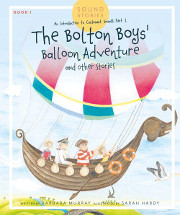The Bolton Boys' balloon adventure and other stories: Sound Stories by Barbara Murray

An Introduction to Consonant Sounds: Part 1. Ill. by Sarah Hardy.
Little Steps Publishing, 2017. ISBN 9781925545074
(Ages: 4-6) Themes: Phonemic Awareness, Synthetic Phonics. This has
been written by the co-author of the Sound Waves resources, which
teach spelling and reading skills using a phonemic approach, and is
one of four books introducing the 43 consonant and vowel sounds used
in the English language. Their aim is to help children hear and
identify individual sounds within speech. This first book contains
12 short stories, each one focussing on a different consonant sound
represented by the letters b, k, d, f, g, h, j, l, m, n, ng, and p.
There are some slight differences between these 43 sounds and the
popular Jolly Phonics programme sounds. Apparently, the Sound Waves
sounds are those specifically heard by Australian children. The
programme, being Australian, is also based on the Australian
Curriculum. The stories are short and simple with a clear narrative
structure, allowing for varied tone and pace when reading aloud. The
book contains an explanation of phonemic awareness and synthetic
phonics and clear guidelines for getting the most out of the
stories. The lists of words using the target sound, in both the
illustrations and the text, are useful, however it would be better
if there were more things within the picture that begin with the
target sound. While most of the pictures are quite detailed and
contain many things beginning with the initial sound, there are a
few that only have two or three. This is understandable for a sound
like ng, but even the j illustration only has a jellyfish. It should
also be noted that the text is small and is not suitable for helping
children to recognise the visual manifestation of the sounds (a
point of difference between the Jolly Phonics introductory books and
this series). This is a great addition for schools using Sound
Waves, but is a useful resource even for those using other synthetic
phonics programmes such as Jolly Phonics.
Nicole Nelson